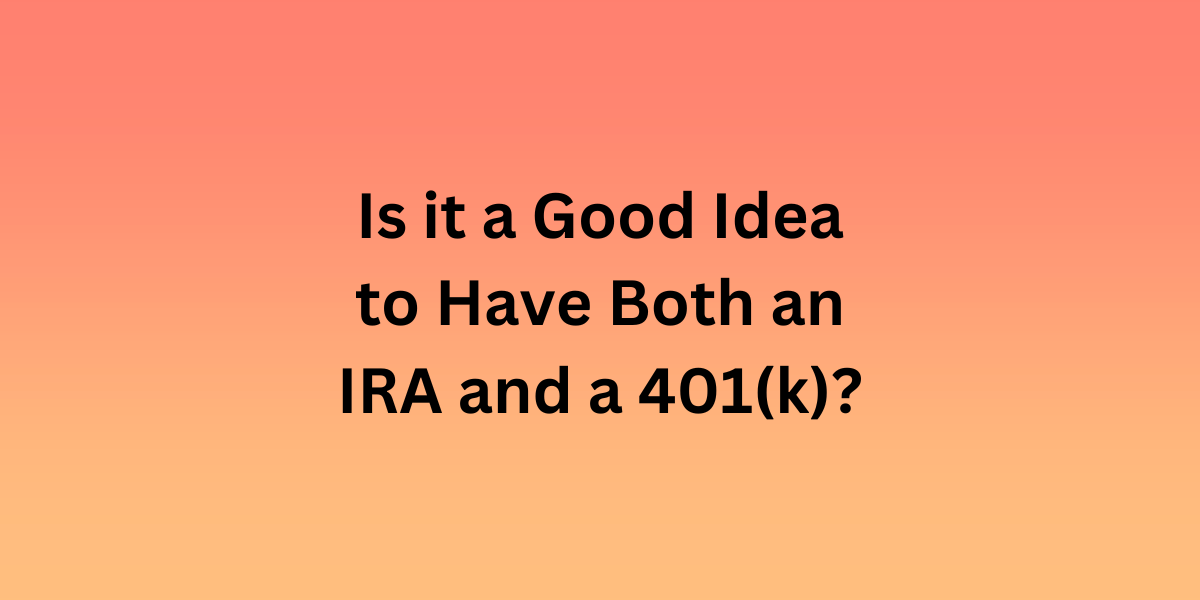Yes, it is generally considered a good idea to have both an Individual Retirement Account (IRA) and a 401(k) if you have the opportunity to contribute to both.
This article explores the benefits of having both accounts and highlights why it might be a good idea to utilize both in your retirement planning.
Saving for retirement is a critical financial goal that requires careful planning and consideration. Two popular retirement savings vehicles, the Individual Retirement Account (IRA) and the 401(k) plan, often come into the spotlight when discussing long-term financial strategies. While each option offers distinct advantages, many experts suggest that having both an IRA and a 401(k) can provide individuals with a robust and diversified retirement savings portfolio.
The combination of an IRA and a 401(k) offers numerous benefits that can enhance your retirement savings strategy. From diversification and increased contribution limits to expanded investment options and potential employer matches, having both accounts provide a comprehensive approach to securing your financial future.
However, it is essential to evaluate your individual circumstances and consult with a financial advisor to determine the most suitable retirement savings strategy for you.
Reasons why having both an IRA and a 401(k) is advantageous
Both retirement accounts offer unique benefits and can work together to enhance your retirement savings.
Diversification of Retirement Savings
Diversification is a fundamental principle in investment strategy, and it holds significant importance when it comes to saving for retirement. Building a diversified portfolio helps spread risk and provides a stronger foundation for long-term financial security. This holds true for retirement savings as well, where diversification plays a crucial role in minimizing vulnerability to market fluctuations and maximizing potential returns.
One effective way to achieve diversification in retirement savings is by utilizing multiple retirement accounts, such as an Individual Retirement Account (IRA) and a 401(k). Each account offers unique features and benefits, allowing you to access a wider range of investment opportunities. By having both accounts, you can tap into the advantages they offer, thus enhancing your ability to diversify your holdings.
By having both an IRA and a 401(k), you diversify your retirement savings across different account types. IRAs come in two main types: Traditional IRA and Roth IRA. Each has its own tax advantages and eligibility requirements. Meanwhile, a 401(k) is an employer-sponsored retirement plan. By spreading your savings across different account types, you create a more balanced and diversified retirement portfolio.
Diversifying your retirement savings is a prudent strategy that can help protect your savings and enhance potential returns. By utilizing multiple retirement accounts, such as an IRA and a 401(k), you can access a broader range of investment options, benefit from tax advantages, and take advantage of employer contributions.
Higher Contribution Limits
When it comes to saving for retirement, contribution limits play a crucial role in determining how much you can set aside each year. One significant advantage of certain retirement accounts, such as a 401(k) and an Individual Retirement Account (IRA), is the availability of higher contribution limits compared to other savings options. The higher contribution limits can be a valuable asset in building a robust retirement nest egg.
A higher contribution limit refers to the maximum amount of money you can contribute to a retirement account within a given tax year. The advantage of higher contribution limits is that they allow you to save and invest more towards your retirement goals, potentially accelerating your savings growth over time. Let’s explore the higher contribution limits associated with 401(k)s and IRAs:
Having both an IRA and a 401(k) allows you to maximize your retirement contributions. By contributing to both accounts, you can take advantage of the higher contribution limits and potentially save more for retirement.
The higher contribution limits associated with 401(k)s and IRAs allow you to potentially save more towards your retirement compared to other retirement savings options. By taking full advantage of these limits, you can maximize your retirement savings potential. Contributing the maximum amount each year can significantly impact the growth of your retirement funds over time, especially when coupled with the power of compounding.
It is essential to note that contribution limits may change over time due to inflation adjustments or legislative changes. It is advisable to stay updated with the latest limits set by the Internal Revenue Service (IRS) or consult a financial advisor to ensure compliance with the current regulations.
Employer Match
One significant advantage of a 401(k) is the potential for an employer match. Many employers offer a matching contribution up to a certain percentage of your salary. This match is essentially free money that can significantly boost your retirement savings. It’s wise to contribute enough to your 401(k) to take full advantage of the employer match before considering additional contributions to an IRA.
When it comes to saving for retirement, one of the most attractive benefits offered by certain retirement plans, such as a 401(k), is the potential for an employer match. An employer match refers to the contribution made by your employer towards your retirement savings based on your own contributions. This additional contribution from your employer can significantly boost your retirement savings and provide a valuable incentive to participate in employer-sponsored retirement plans.
Here’s how employer match typically works:
Contribution Matching:
Many employers offer a matching contribution based on a percentage of the employee’s salary deferral. For example, a common matching formula is 50% of the employee’s contributions up to a certain percentage of their salary. Let’s say your employer has a 50% match up to 6% of your salary. If you contribute 6% of your salary to your 401(k), your employer will match half of that amount, effectively adding 3% of your salary to your retirement savings.
Maximum Match:
Employers often have a maximum limit on the matching contribution they will make. For instance, they may match up to a certain percentage of your salary or a fixed dollar amount. It’s important to understand your employer’s matching policy and contribute enough to receive the maximum match available to you. Otherwise, you’re essentially leaving free money on the table.
Flexibility and Control
When it comes to planning for retirement, having flexibility and control over your retirement savings can be instrumental in meeting your financial goals. Individual Retirement Accounts (IRAs) and 401(k) plans offer individuals the opportunity to have greater flexibility and control over their retirement savings compared to other retirement savings options.
IRAs offer a broader range of investment options compared to 401(k)s, which are typically limited to the investment choices provided by the employer’s plan. With an IRA, you have the freedom to choose from a wide range of stocks, bonds, mutual funds, and other investment vehicles. This flexibility allows you to tailor your investment strategy and align it with your financial goals and risk tolerance.
Having flexibility and control over your retirement savings provides you with the opportunity to tailor your retirement strategy to your unique circumstances and financial goals. It allows you to adapt to changing market conditions, adjust your contributions, and optimize your tax advantages. However, it’s important to consider factors such as contribution limits, withdrawal rules, and tax implications when making decisions regarding your retirement accounts.
In conclusion, both IRAs and 401(k) plans offer flexibility and control over your retirement savings, allowing you to make informed decisions and shape your financial future. By leveraging the investment choices, contribution control, tax planning options, and portability offered by these retirement accounts, you can customize your retirement strategy and increase your chances of achieving a comfortable retirement.
Tax Planning and Roth Conversion Opportunities
Having both an IRA and a 401(k) provides tax planning flexibility. For example, if you have a Traditional IRA and a 401(k), you can strategically plan your withdrawals during retirement to optimize your tax situation. Additionally, if you have a Traditional IRA, you may have the opportunity to convert it to a Roth IRA through a Roth conversion. This can provide potential tax benefits by allowing you to pay taxes on the converted amount now and enjoy tax-free withdrawals in retirement.
Tax planning is a critical aspect of retirement savings, and understanding the benefits of Roth conversions can provide individuals with valuable opportunities to optimize their tax strategies. Roth conversions involve transferring funds from a Traditional IRA or a pre-tax retirement account, such as a 401(k), to a Roth IRA. This conversion can have significant tax advantages and create additional flexibility in retirement planning.
Conclusion
While having both an IRA and a 401(k) offers numerous benefits, it’s essential to consider your specific financial situation, goals, and available resources. It’s advisable to consult with a financial advisor or retirement planning professional who can provide personalized guidance based on your circumstances and help you make informed decisions about your retirement savings strategy.
Disclaimer: The information for this written post has been taken from various sources on the internet. While we strive to provide accurate and reliable information, but cannot guarantee the accuracy or completeness of the information. Please use your discretion before making decisions or taking actions based on that information. Therefore, any reliance you place on such information is strictly at your own risk.









